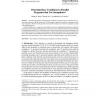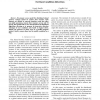57 search results - page 1 / 12 » Detecting Race Conditions in Parallel Programs that Use Sema... |
CORR
2002
Springer
13 years 4 months ago
2002
Springer
Abstract. We address the problem of detecting race conditions in programs that use semaphores for synchronization. Netzer and Miller showed that it is NP-complete to detect race co...
ISSTA
2006
ACM
13 years 10 months ago
2006
ACM
Concurrent programs are notorious for containing errors that are difficult to reproduce and diagnose. A common kind of concurrency error is deadlock, which occurs when some thread...
PPOPP
2011
ACM
12 years 7 months ago
2011
ACM
In recent years, GPUs have emerged as an extremely cost-effective means for achieving high performance. Many application developers, including those with no prior parallel program...
CORR
2011
Springer
12 years 10 months ago
2011
Springer
—We present a new model for distributed shared memory systems, based on remote data accesses. Such features are offered by network interface cards that allow one-sided operations...
EUROPAR
2004
Springer
13 years 9 months ago
2004
Springer
In this paper we show that data races, a type of bug that generally only causes havoc in parallel programs, can also occur in sequential programs that use signal handlers. Fortunat...


